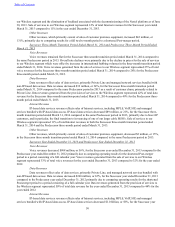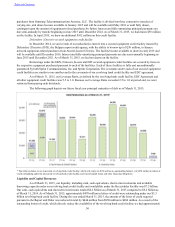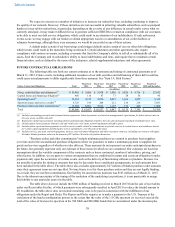Sprint - Nextel 2014 Annual Report Download - page 53
Download and view the complete annual report
Please find page 53 of the 2014 Sprint - Nextel annual report below. You can navigate through the pages in the report by either clicking on the pages listed below, or by using the keyword search tool below to find specific information within the annual report.
Table of Contents
51
ended December 31, 2013 compared to the Predecessor year ended December 31, 2012 primarily due to comparing operating
results for the shortened Post-merger period to a period consisting of a full calendar year. Sale of services to our Wireless
segment represented 11% of total Internet revenues for both the years ended December 31, 2013 and 2012.
Other Revenues
Other revenues, which primarily consist of sales of customer premises equipment, decreased $43 million, or 57%
in the Successor year ended December 31, 2013 compared to the Predecessor year ended December 31, 2012, primarily due
to comparing operating results for the shortened Post-merger period to a period consisting of a full calendar year.
Combined Year Ended December 31, 2013 and Predecessor Year Ended December 31, 2012
Voice Revenues
In addition to the explanations above, voice revenues for the Combined year ended December 31, 2013 compared
to the Predecessor year ended December 31, 2012 decreased as a result of overall volume and price declines, of which $53
million was related to the decline in prices for the sale of services to our Wireless segment, as well as volume declines due to
customer churn.
Data Revenues
In addition to the explanations above, data revenues for the Combined year ended December 31, 2013 compared
to the Predecessor year ended December 31, 2012 decreased as a result of customer churn driven by the focus to no longer
provide frame relay and ATM services.
Internet Revenue
In addition to the explanations above, Internet revenues for the Combined year ended December 31, 2013
compared to the Predecessor year ended December 31, 2012 decreased primarily due to fewer IP customers.
Costs of Services
Costs of services include access costs paid to local phone companies, other domestic service providers and foreign
phone companies to complete calls made by our domestic subscribers, costs to operate and maintain our networks, and costs
of equipment.
Successor Year Ended March 31, 2015 and Successor Year Ended December 31, 2013
Costs of services increased $1.1 billion, or 89%, for the Successor year ended March 31, 2015 compared to the
year ended December 31, 2013 primarily due to comparing results for a full twelve-month period to a shortened Post-merger
period. Offsetting the increase was a decrease primarily due to lower access expense as a result of savings initiatives and
declining volumes, which resulted in an overall decrease in cost of services when comparing the Successor year ended March
31, 2015 to the Combined year ended December 31, 2013. Service gross margin percentage decreased from 25% in the
Successor year ended December 31, 2013 to 17% in the Successor year ended March 31, 2015 primarily as a result of a
decrease in net service revenue partially offset by a decrease in cost of services.
Successor Three-Month Transition Period Ended March 31, 2014 and Predecessor Three-Month Period Ended
March 31, 2013
Costs of services increased $7 million, or 1%, in the Successor three-month transition period ended March 31,
2014 compared to the same Predecessor period in 2013 primarily due to higher contractual rates impacting facility costs.
Service gross margin percentage decreased from 26% in the Predecessor three-month period ended March 31, 2013 to 13% in
the Successor three-month transition period ended March 31, 2014 primarily as a result of a decrease in net service revenue
combined with a slight increase in cost of services.
Successor Year Ended December 31, 2013 and Predecessor Year Ended December 31, 2012
Costs of services decreased $1.5 billion, or 56%, in the Successor year ended December 31, 2013 compared to the
Predecessor year ended December 31, 2012 primarily due to comparing operating results for the shortened Post-merger
period to a period consisting of a full calendar year. Service gross margin percentage decreased from 28% in 2012 and to
25% in 2013, primarily as a result of a decrease in net service revenue partially offset by a decrease in cost of services.
Combined Year Ended December 31, 2013 and Predecessor Year Ended December 31, 2012
In addition to the explanations above, costs of services for the Combined year ended December 31, 2013
compared to the Predecessor year ended December 31, 2012 decreased primarily due to lower access expense as a result of
declining voice, data and Internet volumes.
























